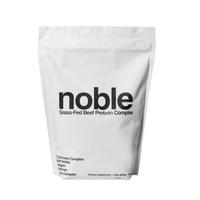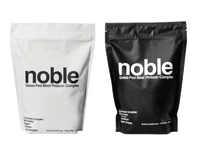
The Noble Guide to Rib Eye Steak Nutrition
Share
Are you a steak enthusiast wondering about your favorite ribeye cut's nutritional profile? A 3-ounce serving of this mouthwatering delight packs a whopping 248 calories.
This article will take you on a delicious journey, delving into the nitty-gritty of ribeye steak nutrition, from its essential vitamins and minerals to its contribution towards maintaining heart health.
Get ready; it's time to feed your body and mind with savory knowledge!
Key Takeaways
- Ribeye steak is a nutritious red meat with protein, vitamins, and minerals.
- A 3-ounce serving of ribeye ribeye has about 248 calories, with fats and proteins making up the bulk.
- The Steak contains good (unsaturated) and less healthy (saturated) fats, but portion control can keep the diet balanced.
- Ribeye steak can be prepared by grilling, skillet cooking, or oven-roasting.
Understanding the Nutritional Value of Ribeye Steak

Dive into the wealth of nutrients in a ribeye steak, from its high protein content to beneficial vitamins and minerals.
You'll also explore the caloric value of your favorite cut, assessing how it fits into your daily nutritional needs.
Let's unearth what makes this famous Steak not just mouth-wateringly delicious but truly nourishing, too!
Essential nutrients in ribeye steak
A feast of ribeye steak offers a satisfying taste and a nutritious meal. Let's explore the critical nutrients packed in every bite:
- Protein: Ribeye steak is a protein powerhouse essential for preserving and enhancing muscle mass. (1)
- Saturated Fat: About 8 grams sit in each 3-ounce serving, which is necessary for hormone production and the absorption of vitamins.
- Trans Fat: Despite its bad reputation, trans fat naturally occurs in meat products like ribeye ribeye steak at about 3 grams per 3-ounce serving.
- Polyunsaturated Fat: This type of heart-friendly fat accounts for around 9 grams in your ribeye serving.
- Monounsaturated Fat: Like polyunsaturated fats, monounsaturated fats are suitable for the heart, with approximately 9 grams found in ribeye ribeye steak.
- Calories: Each serving dishes out around 248 calories, supplying the body with energy to carry out daily activities.
- Iron & Zinc: Besides these critical nutrients, ribeye steak is rich in iron and zinc, essential for metabolism and a robust immune system.
- Vitamins B12 and B6: These vitamins aid in nerve function and play a vital role in brain development.
Caloric content of ribeye steak
A 3-ounce serving of ribeye steak packs quite a punch in terms of calories. You'll find approximately 248 calories within this tasty portion, making it an energy-rich meal choice.
The caloric content primarily comes from the protein and fat present in the meat.
However, not all these calories are created equally. Ribeye steak boasts a well-balanced mix of both saturated and unsaturated fats.
While saturated fats contribute to their deliciously rich flavor, unsaturated fats provide essential fatty acids your body needs for various physiological processes.
Also noteworthy is that ample portion size can effectively fuel your daily activities or post-exercise recovery without exceeding typical calorie needs.
Look at this detailed breakdown of the nutritional facts for a 3-ounce serving of ribeye steak.
| Nutrient | Amount |
|---|---|
| Calories | 248 |
| Saturated Fat | 8g |
| Trans Fat | 3g |
| Polyunsaturated Fat | 9g |
| Monounsaturated Fat | 9g |
| Cholesterol | 68mg |
| Sodium | 46mg |
This table provides a clear picture of the nutritional composition of ribeye ribeye steak, a favorite among carnivore dieters and meat lovers.
The Balance of Fats in Ribeye Steak
Ribeye steak offers a unique blend of fats in every juicy bite. For a 3-ounce serving, you'll get 8 grams of saturated fat and 9 grams of heart-healthy mono and polyunsaturated fats. Animal products provide saturated fats, whereas mono and polyunsaturated fats are heart-healthy.
The marbling in ribeye steaks, those delicate veins of fat running through the meat, primarily consist of monounsaturated fat.
This type also helps lower harmful cholesterol levels when eaten in moderation.
Moving on to trans-fat content, reports indicate that ribeye contains about three grams per helping.
It's important to note that while trans fats generally have a negative reputation due to their association with increased heart disease risk, the naturally occurring trans fats found in beef are not as harmful as industrially produced ones. (2)
The key here is balance; incorporating ribeye into your diet can provide you with an ample amount of both beneficial and less beneficial kinds of fats.
As ever with nutritional matters, portion control stands paramount - even too much good fat can tip your overall diet off balance!
So grill up that Steak, but remember: savor it as part of a varied and balanced dietary regimen.
3 Great Ways to Prepare Ribeye

Let's jump into some fantastic ways to cook a RibeyeRibeye steak for all the carnivore diet followers and meat lovers.
- Grilling: This method imparts that signature smoky flavor to your RibeyeRibeye steak. You only need a well-heated grill, some salt, and pepper. Make sure your Steak is at room temperature before you start grilling.
- Skillet Cooking: A cast-iron skillet can sear your Steak to perfection. After heating the skillet on high, add your seasoned RibeyeRibeye into it. Keep flipping until both sides have a beautiful crust.
- Oven Roasting: Ideal for those who prefer their steak medium or well-done, oven roasting allows for even cooking. Remember to heat your oven and use a pan or dish that can go in it.
Conclusion: The Healthiness of Ribeye Steak
Savoring a ribeye steak is a treat for your taste buds and a boon for your health. Packed with essential proteins, vitamins, and minerals, this succulent cut of meat is a cornerstone of a well-rounded diet. (3)
But why stop at just the Steak?
For those looking to elevate their nutritional intake, Noble Origins offers a holistic approach.
Our Noble Organs Complex provides concentrated nutrients from grass-fed beef organs.
And if you're aiming for a protein boost with added benefits, our Nose-To-Tail Protein With Organs, Collagen, & Colostrum is the perfect complement to your meals.
So, as you indulge in the rich flavors of ribeye ribeye, consider giving your body an extra nutrient-rich boost with Noble Origins.
Dive deep into holistic nutrition and let every meal be a testament to your commitment to health and wellness.
Explore Our Grass-Fed Protein Powders and organ Blends and elevate your dining experience.
FAQs
What are the nutritional facts of Rib Eye Steak?
A 3-ounce broiled ribeye steak offers 199 calories, 10.8g of fat, 0g of carbohydrates, and 23.8g of protein. It's a rich source of zinc, vitamin B6, and B12 and also provides iron.
What health benefits do I get from eating a ribeye steak?
Ribeye steak can help manage weight, maintain muscle mass, and lower the risk of age-related muscle loss called sarcopenia. It also prevents anemia due to its iron and vitamin B12 content. Furthermore, the protein and zinc in ribeye steak support a healthy immune system.
How does the nutrition differ among varieties of Rib ribeye steaks?
The nutritional difference between Grain-Fed and Grass-Fed ribeye or USDA Prime ribeye versus American Wagyu ribeye mainly lies in their omega-6 to omega-3 fatty acid ratios. Grass-fed beef typically has a better omega-6 to omega-3 ratio, which benefits heart health.
Are there any potential adverse effects while consuming Rib Eye Steak?
Excessive consumption of ribeye steak can increase saturated fat intake, which might elevate cholesterol levels. Additionally, some individuals might experience an "alpha-gal" allergy from tick bites, leading to allergic reactions after consuming red meat like a ribeye steak.
How should I store my Steak for Steak?
Ribeye steaks should be refrigerated if consumed within a few days. For more extended storage, freezing in air-tight plastic wrap is recommended. Ensure proper handling at all stages to maintain freshness and safety.
What's the best way to cook a Rib ribeye steak?
Broiling and grilling are popular methods for cooking ribeye steak. However, skillet cooking, oven roasting, and smoking are also practical. Pairing the Steak with Steak Ables or whole-grain side dishes can enhance the dining experience.
Related Studies
- A study published in Men's Health discussed that ribeye steak is a good source of protein, with 3 ounces containing around 24 grams of protein.
- A study published in Men's Health states that naturally occurring trans fats in beef are different from industrially produced ones, and are not considered harmful in moderate amounts.
- A study published in Healthify Me highlights the ribeye steak as high in fat, it is still a healthy option when consumed in moderation as part of a well-balanced diet.



